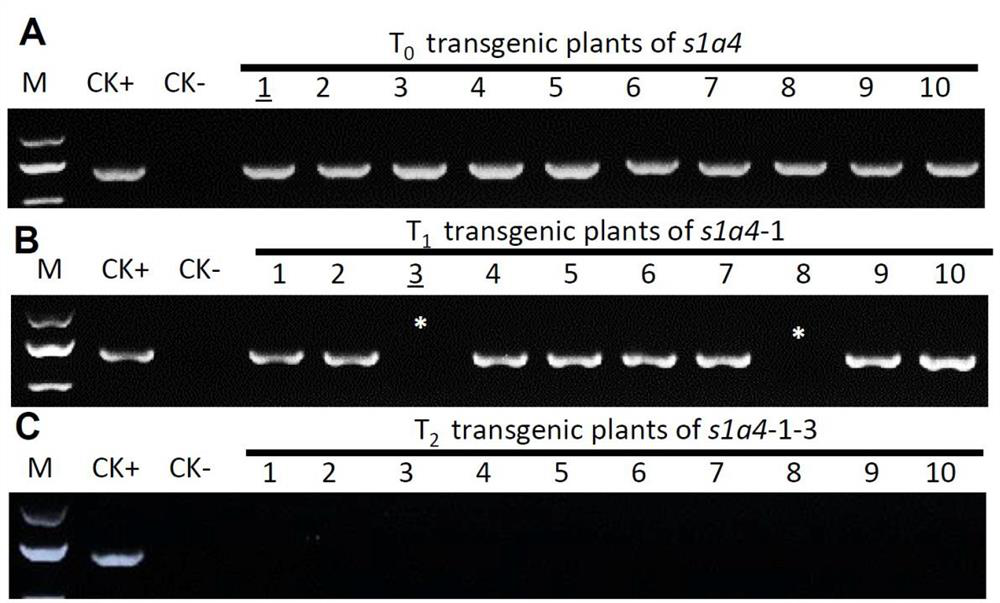A gene s1a4 controlling sterility in Asian-African rice hybrids and its application
An S1A4, gene technology, applied in the field of genetic engineering technology and crop genetics and breeding, can solve problems such as restricting the application of Asian-African rice hybridization, and achieve the effect of eliminating hybrid sterility and improving crop yield.
- Summary
- Abstract
- Description
- Claims
- Application Information
AI Technical Summary
Problems solved by technology
Method used
Image
Examples
Embodiment 1
[0037] Example 1. Functional identification of the key gene S1A4 of the S1 locus hybrid sterile gamete lethal system
[0038] The S1 gene locus of interspecific hybrid sterility in Asian-African rice is a hybrid sterility locus that simultaneously controls female and male gamete sterility, and there are 6 expressed genes in the S1-g interval ( figure 1 A), among them, S1TPR and S1A6 (SSP) are the reported hybrid sterility genes involved in the S1 locus (Xie et al. 2017; Koide et al. 2018).
[0039] 1. Transforming the S1TPR and S1A6 double-gene vectors into the parents of O. sativa
[0040] 1. Experimental method
[0041] (1) Using the primers in Table 1, the S1TPR and S1A6 genes were amplified from the African rice genome, and then the amplified fragments were cloned into the EcoRI and BamHI sites of the binary vector pCambia1300 using the Giboson assembly ligation method.
[0042] The Giboson assembly ligation method was as follows: cut 100 ng of pCambia1300 into lines wit...
Embodiment 2
[0059] Example 2. Gene knockout of S1A4 using CRISPR / Cas9 technology
[0060] 1. Experimental method
[0061] According to the nucleotide sequence of the S1A4 gene (the nucleotide sequence is shown in SEQ ID NO: 1, and the amino acid sequence encoded by it is shown in SEQ ID NO: 2), a 20bp sequence is selected in the S1A4 exon (the nucleotide sequence is shown in SEQ ID NO: 2). ID NO: 3 TGATAGAGCCCAAGAATCGG) as the S1A4 knockout target. The target linker sequence (U6a-S1A4-F / U6a-S1A4-R, nucleotide sequence shown in SEQ ID NO: 4-5) was denatured and then ligated into the sgRNA expression cassette intermediate vector pLYsgRNA-OsU6a.
[0062] Utilize the primer pair Pps-GGL / Pgs-GGR in Table 2 to amplify the expression cassette primer (nucleotide sequence shown in SEQ ID NO: 6-7), and connect it into the CRISPR / Cas9 vector. The constructed CRISPR / Cas9 vector was transformed into Agrobacterium EHA105, and introduced into the near isogenic line NIL-g containing African rice S1-g t...
Embodiment 3
[0070] Example 3 Obtaining the s1a4 mutant that does not carry the transgenic element
[0071] Using the marker of the transgenic hygromycin resistance screening gene HPT, the transgenic elements of the knockout vector (containing Cas9 gene, guide RNA / sgRNA, and hygromycin resistance gene HPT) were separated for multiple generations, and isolated without transgenic elements s1a4 mutant.
[0072] 1. Experimental method
[0073] Extract the T of s1a4 0 ,T 1 and T 2 Using the genomic DNA of the first generation as a template, use the primer pair Hpt-F / Hpt-R in Table 4 to amplify the partial sequence of the HPT gene to determine whether the transgenic element exists or not.
[0074] Table 4 Transgenic plant detection primers
[0075]
[0076] 2. Experimental results
[0077] Such as figure 2 shown, at T 0 In this generation, 10 positive transgenic plants were obtained, and then the progeny of line 1 (s1a4-1) was analyzed, and T 1 No. 3 and No. 8 lines in the progeny l...
PUM
 Login to View More
Login to View More Abstract
Description
Claims
Application Information
 Login to View More
Login to View More - R&D
- Intellectual Property
- Life Sciences
- Materials
- Tech Scout
- Unparalleled Data Quality
- Higher Quality Content
- 60% Fewer Hallucinations
Browse by: Latest US Patents, China's latest patents, Technical Efficacy Thesaurus, Application Domain, Technology Topic, Popular Technical Reports.
© 2025 PatSnap. All rights reserved.Legal|Privacy policy|Modern Slavery Act Transparency Statement|Sitemap|About US| Contact US: help@patsnap.com



